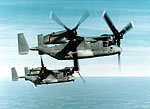Pentagon plans 4 new helos
 The Pentagon is fleshing out its plans to change the way it buys and develops helicopters and tilt-rotor aircraft.
The Pentagon is fleshing out its plans to change the way it buys and develops helicopters and tilt-rotor aircraft.
The military is discarding its ”as-needed” approach to purchases and upgrades in favor of a “balanced transformational strategy,” according to its Strategic Plan for United States Department of Defense Vertical Lift Aircraft, unveiled Aug. 27 and presented three days later to Congress.
Officials in the defense research and engineering arm of acquisition deputy of the Office of the Secretary of Defense are working to put meat on the plan’s bones. The individual services are providing input; they will ultimately be responsible for executing the plan.
The plan envisions four new “joint multirole” rotorcraft: light, medium, heavy and ultra-sized. The aircraft would be equipped with common systems for situational awareness, avionics, engines, countermeasures and “repairables” that can be used by each service.
They would be developed sequentially, with the new technology for each applied to the next, the plan says.
The timeline is not set; Defense Department officials say the new aircraft should arrive in time to replace the oldest aircraft in the military’s fleets.
Pentagon officials also want a “significant increase” in research and development funds to allow the helicopter industry to develop “next-generation capabilities” for fielding between 2020 and 2050. An annual boost of $110 million in science and technology funding is needed to develop the technology to allow military officials to choose between extending the lives of the current fleet or buying new aircraft, the plan says.
The report notes that the military has focused on upgrades to its rotorcraft instead of clean-sheet designs during the past near-decade of war. That trend plus other “downward trends in science, technology and engineering” in the rotorcraft industrial base “pose significant risks in addressing the future of DoD requirements,” the report says.
That future includes combat scenarios that will “challenge the capabilities of the current vertical lift fleet,” the report says.
The answer: develop the “breakthrough technology and new aircraft starts required to achieve next generation vertical lift capabilities.”
The report says the defense industry will need to spend its own cash on research and development and in collaboration with the Pentagon field “multiple flying technology demonstrators to achieve” technology breakthroughs in a “reasonable time.”
Due to the wars in the Middle East, “production funding [for old designs] is at an all-time high,” while rotorcraft R&D funds are at an all-time low, Phil Dunford, Boeing’s then-chief of rotorcraft systems, said in July.
The helicopter industry has simply upgraded airframe designs that are up to 50 years old, Dunford said. In some cases, helicopters are as vulnerable to small-arms fire, rocket-propelled grenades and brownouts as they were during the Vietnam War, the Boeing executive said.
“It’s time [for industry] to think about where we’re going to collaborate and where we’re going to compete,” Dunford said.
The helicopter industry, at DoD’s urging, formed a future vertical lift consortium to do just that.
Still it is “notoriously difficult to get the services to harmonize their helicopter requirements,” however cheap and efficient the notion of common choppers may be, Teal Group analyst Richard Aboulafia said. “That’s particularly clear now, with the” services developing modified versions of “seven basic airframes, and some very different design approaches.”
It will be “tough to do better” than the Skiorsky UH-60 Black Hawk program, which supplies various variants to all four services, Aboulafia said.
As always, funding for the development of new aircraft will make or break the initiative..
“The technology might not be there to justify all-new airframe designs anyway,” Aboulafia said. “This means the services will have every reason to stick with the airframes they’re familiar with.”